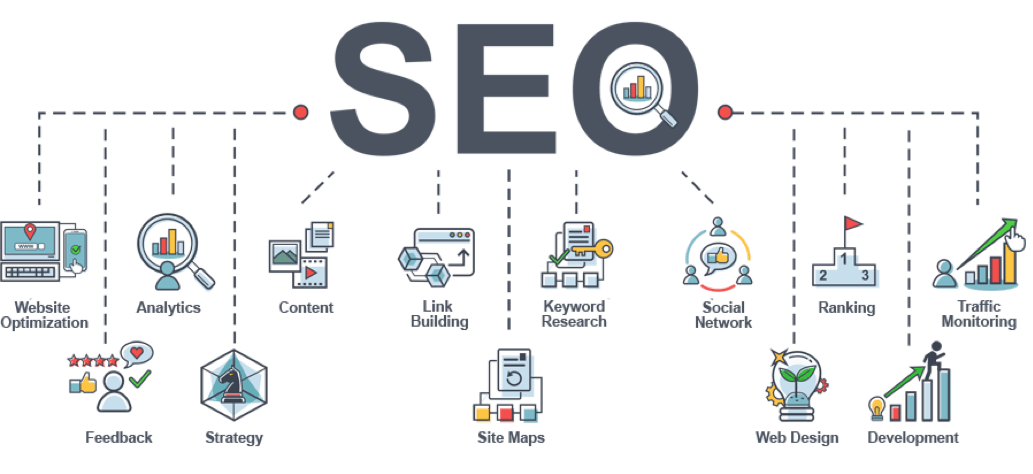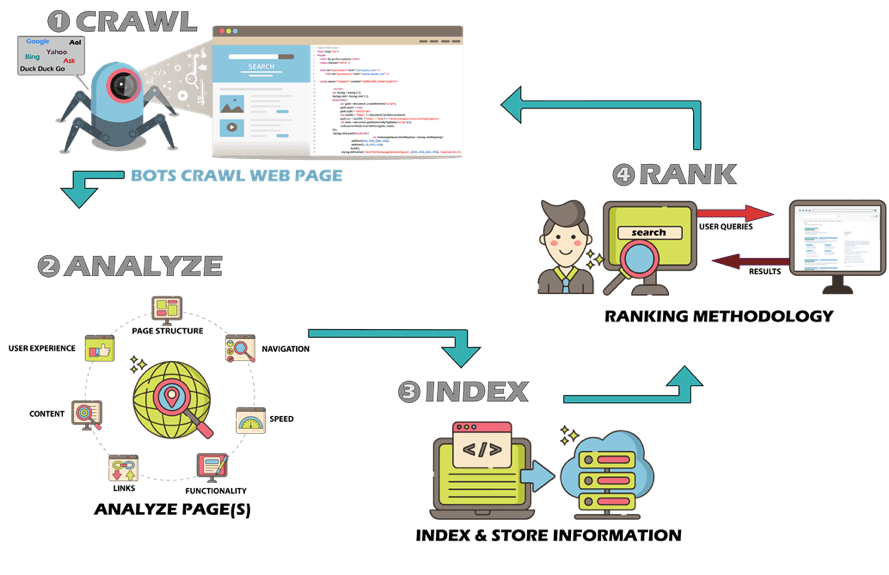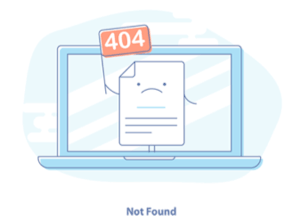By David Montalvo, VP, Web Marketing Services, UnReal Web Marketing, A Reach Marketing Company
Everyone from small business owners to marketing agencies is beginning to see the value in mastering SEO. SEO marketing is a growing industry flooded with experts. And, though the rules change frequently as Google updates their algorithm, there are some tenants to SEO strategy that have stayed the same over the past decade. Learn more about SEO and start to reap the results of an SEO strategy, starting with this guide.
What is SEO?
‘Search engine optimization‘, commonly referred to by its abbreviation SEO, is the method of enhancing your website’s organic ranking across various search engines, resulting in an increase in the quality and quantity of your traffic. While there are a number of paid techniques companies utilize to drive traffic, SEO relies on the employment of organic tactics and strategies to help secure higher placement on a search engine’s results pages. An SEO strategy is integral to any marketing plan. It’s also the piece of your marketing efforts that will require the most patience and 360-degree integration.
There are a number of standard techniques that need to be employed when it comes to creating the ultimate SEO strategy as well as benchmarking and measurement practices to help understand SEO results and drive ROI. Content creation, schema markup, keyword optimization, voice search, link building, and cross channel integration are a few building blocks to how SEO works. Measuring how these relate to each other is essential for companies to roll out their plans in a measured and consistent way. Let’s explore the variety of different elements and approaches needed to build a robust SEO marketing strategy.
The Basics: Understanding Google’s Algorithm

Google’s Algorithm
Though many have tried, no one has yet to depose Google as the leader of all search engines. If you want to succeed in the SEO game, it’s imperative to understand how the rules are laid out by the almighty algorithm that supports the Google search engine ecosystem. In short: SEO results and rankings are directly related to how Google’s algorithm operates.
Before we attempt to dissect the inner workings of the Google algorithm, it’s important to understand what an actual algorithm is. An algorithm, according to Dictionary.com, is “a set of rules for solving a problem in a finite number of steps.” There are numerous scenarios where the use of an algorithm can occur to solve a problem. Algorithms are common in mathematics: when solving a mathematical equation, it is imperative to understand the specific steps needed to solve the problem. The same theory applies to computer language as well. Computer programmers create algorithms that essentially instruct the computer how to perform a specific task in a specific order, step by step, to garner a particular result.
So how does this apply to SEO? Google uses an algorithm to manage how sites organically appear as the result of a user’s search query. When you type a question into Google, the Google algorithm goes to work by scrolling through web pages that contain specific keywords, ranks them based on a number of different elements, and presents the best pages based on what it deems most relevant to your search.
Unfortunately, the weighting and correlation of that decision-making, along with the inner workings of the Google algorithm, in general, remains under lock and key. Google makes several changes to its algorithm every year. The best practices for mastering SEO are constantly in flux, as experts continually offer advice on what you should and shouldn’t be doing to improve your SEO results.
What we do know, that despite the constant changes, is that there are two main categories that best classify the multiple factors that the Google algorithm takes into account when determining a page’s ranking. These are called on-page SEO factors and off-page SEO factors.
On-Page SEO Factors
On-page SEO factors partly determine the ranking of your website in accordance with Google’s search engine. This term refers to all the different elements that you can actually control on your own website to help influence your ranking.
Off-Page SEO Factors
Where on-page SEO factors are to actions and elements directly related to activity on your own website, “off-page SEO factors” is a term referring to elements occurring outside of your website itself. These factors include social media traffic, your online marketing activities and most importantly, links to your web pages from other sites. Your page’s position on Google will improve based on the number and quality of external relevant sites that directly link or point towards your website.
Understanding On-Page SEO Factors
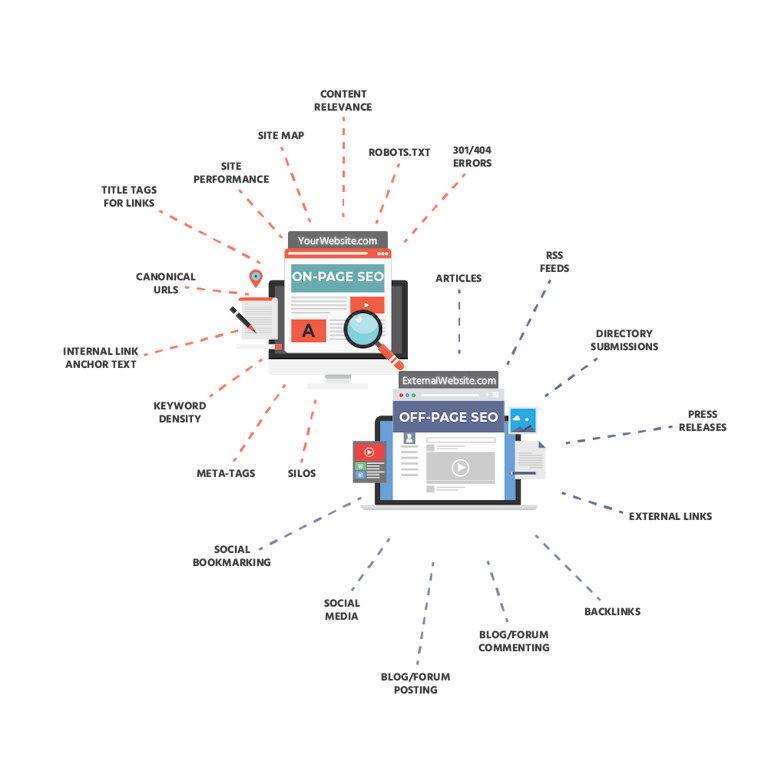
On-Page & Off-Page SEO Factors
SEO is a 360-degree ecosystem, where building your strategy requires a combination of a myriad of different elements that constantly interplay with each other to create an effective approach.
While there are numerous theories surrounding how best to tackle SEO, nearly every expert recommends paying close attention to on-site SEO factors that affect your website design. There are five main on-page SEO components that matter most when building your SEO strategy.
1. User Engagement
User engagement is a metric that covers how people interact with your website. This impacts how your site will be ranked by Google’s algorithm and, inevitably, your SEO ranking.
Though it may feel like an indirect correlation, Google’s aim is to deliver the best results for its users. Therefore, it makes sense that Google will favor websites that perform across a number of usability areas over other sites. User engagement encompasses a number of elements you need to optimize, highlighting where you should be concentrating your efforts to increase user engagement across your webpages. Here are some tactical areas where you can begin to optimize user engagement.
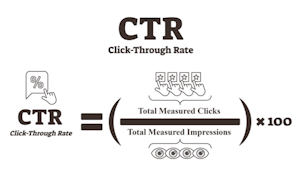
Click-Through Rate (CTR) Formula
Click-Through Rate
When your website appears in a search engine results page (SERP), it’s often the first place a user will interact with your branding and messaging. Click-Through Rate (CTR) from a search listing to your website is indicative of whether you were able to capture a user’s attention enough to get them to engage with your site.
CTR can be improved by integrating the right keyword optimization strategy into your tags and meta description so that it’s an exact match for what users are searching for. Your tags should adhere to the allotted length. Offer a compelling reason for people to click through to your website by writing a detailed and relevant site description.
Return Visitors
Return visitors is a metric of the number of times a user returns to your site. A healthy return rate is approximately 15%. What are you doing to keep people coming back? From an SEO strategy perspective, this would include constantly providing fresh, engaging content that incorporates a keyword optimization plan. Make sure you’re continuing to create copy that is compelling and relevant.
Pages Per Session
Pages per session is a metric that tracks the number of pages viewed by a user during a single visit before they click off the page. Pages per session is a good indicator as to how compelling and engaging your website is, as well as the ease of navigation and user interface. If users are spending a significant amount of time on your website consuming content, it’s fair to say that you’ve created an engaging online experience.
Bounce Rate
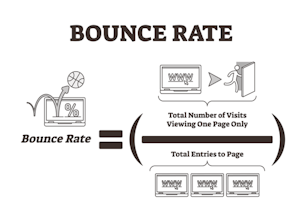
Bounce Rate Formula
Your bounce rate is one of the key determining factors indicating how successful your website truly is. Are you optimizing your experience to encourage visitors to perform a particular function while on your site? Knowing where users are “bouncing,” or leaving your page, is key to improving the user experience overall. It gives you insight into where you can insert various calls to action to encourage particular behaviors, such as ‘buy now’ or ‘stream here’.
Certain pages will naturally have higher bounce rates depending on relevance and calls to action. Monitor where users are bouncing and determine why. What is deterring people from taking the key action? This will inform what changes need to keep visitors browsing longer or send them to where they need to go.
Bounce Rate Averages:
- 26 to 40 percent = excellent
- 41 to 55 percent = average
- 56 to 70 percent = higher than average
- More than 70% for everything outside of news, blogs, or events = poor
2. Structure
Setting your site up for success from a technical and structural standpoint is at the cornerstone of your success. Technical SEO refers to the optimization of your website’s infrastructure, or what’s commonly known as the backend of your page. Technical SEO works in conjunction with your SEO keyword and content efforts by preparing your website for indexing and crawlability, enabling search engines to access, crawl, interpret and index your website with ease.
Crawlability
Search engines have crawlers operating around the clock checking for changes and refreshes of your site, so making your site crawlable is key. Through the use of links via your sitemap and homepage, search engines are able to crawl, or follow your links, to locate your website. Then, save an HTML version of your webpage as an index.
Crawlability is established by a number of different elements, including a crawl budget and crawl rate. A crawl budget is the number of pages the spider crawls and indexes on a website within a given timeframe. One can also prioritize which pages get crawled and indexed first. Your crawl rate refers to the number of requests per second a spider makes to your site while crawling.
To optimize crawling on your website, block any pages you don’t want crawled and clean up and redirect changes.
Clean URLs
Clean URLs can often be overlooked when it comes to maintaining the integrity of your backend structure. There is nothing worse than having broken links or pages that redirect to the wrong place because the URLs are not adhering to the proper structure. Make sure that you have clean URL structures with status 200 codes. This class of status codes indicates the action requested by the client was received, understood, and accepted.
Example:
Not optimal: http://example.com/services/index.jsp?category=medicall&id=sonography Optimal: http://example.com/services/medical/sonography
Security
Security is of the utmost importance to users when interacting with your site, especially when it comes to transactions and e-commerce. Not surprisingly, security has become important to Google, who now consider it as a soft ranking factor.
By implementing HTTPS encryption to secure your website, you offer users a more secure environment for both transactions and browsing. HTTPS is rapidly overtaking HTTP as the standard approach because of the security element. If you still have mixed links, it’s time to clean them up and make sure you’re directing everyone through the correct HTTPS URL.

SEO & Website Security
It takes five steps to set up HTTPS on your website:
- Host with a dedicated IP address
- Buy a certificate
- Activate the certificate
- Install the certificate
- Update your site to use HTTPS
3. Content
Marketers know: content is king. However, not all content is created equal. In fact, 91% of content garners no traffic at all from Google. The question then remains, what type of content do we need to create in order to fall into the 9% of content that does get the traction you need?
User Relevant Content
Creating content that is relevant to your user might seem obvious, but it’s staggering how few companies are able to truly speak to their users’’ needs. Utilize blog content or general website copy to meet user intent; this will help drive traffic and improve SEO value.
Google’s algorithm is continually updated, and these updates impact the nuances of content more than most other SEO elements. The algorithm gets smarter and smarter at recognizing the nuances of a user’s search query. And, its ability to decipher the connotation of search queries means that brands need to work even harder to ensure that their onsite content has direct relevance to a user. Google is placing a higher value on relevance to ensure that a higher value is delivered each time a search is made.
One way to ensure your content is working for you is to ensure your keywords directly relate to the intent of your user. Take that a step further by surveying where and how your keywords are showing up across Google. For instance, search engine results pages, commonly referred to as SERPS, are the precious real estate we all fight for to maximize visibility. Make sure you are surveying the pages that relate to your keywords in order to understand what content is ranking and why. Make changes accordingly to what is getting the most traction.
Long-Form Content
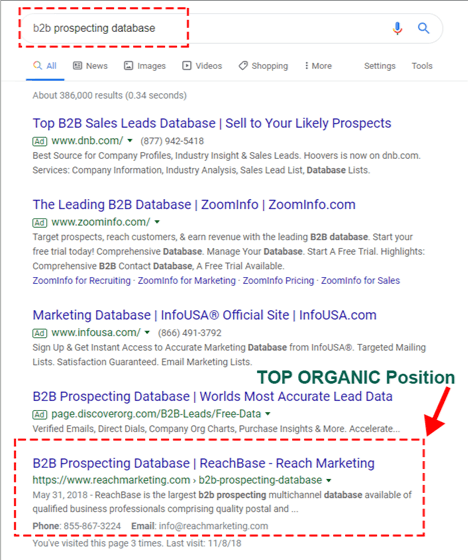
SEO & Content Structure
The rise of long-form content has been a steady one due to Google’s emphasis on higher quality content in their ranking system. On average, articles and blogs between 2,250 and 2,500 words garner the most organic reach. However, while length does matter, it is the quality and relevance of the content that will win out in the end. Find the right balance between the two to create the right type of applicable content that drives engagement.
Keyword optimization will continue to play a major role in making sure your content gets the traffic you need. But, your placement and usage of those keywords will help you gain an edge. Explore topics and additional areas of interest around those keywords to add a much-needed dimension and ensure you’re developing copy that matches users’ search behaviors. Make sure you’re researching what others are saying about your topic so you have the most up-to-date talking points. Consider the intent behind a search query to cover the most pertinent questions users are searching for.
Content Structure
Organizing your content in accordance with SEO best practices is fundamental to making sure users find your content. Inserting focused keywords into title tags and page titles. Create header sections through the utilization of header tags.
The benefits of these practices include:
• Making your web pages easily scannable
• Making it easy for search engines to find your page
• Make it straightforward for readers to navigate your page
• Lower bounce rates with relevant content
Interlinking
Interlinking is the practice of adding links in your copy to other topical articles on your website, encouraging readers to jump between content on your site seamlessly. Interlinking increases session time, internal link popularity and reduces bounce rate.
Interlinking falls under the guise of technical SEO and helps to improve crawlability, link building, and UI. Give users a way to find as much relevant content on your site as possible; this keeps users engaged longer. The main link strategies you can employ to make the most out of your content are embedded in the organization and hierarchy of your links. Where do the links lead, and which links are the most popular?
5. Mobile Responsiveness

Google Mobile Indexing
With numbers tipping further and further towards mobile usage over desktop, it’s imperative that your website is mobile-friendly across all devices. Your page must load at the fastest possible speed.
From an SEO perspective, Google has taken this one step further. Starting July 1, 2019, Google officially rolled out mobile-first indexing, changing their traditional approach away from desktop to utilizing the mobile version of the content as their first port of call in their ranking system.
The more mobile usage takes precedence over desktop, the more changes we can expect to see in how SEO is managed, as well as ranked and indexed based on every changing user behaviors.
What to Know About Off-page SEO
Where on-page SEO refers to actions directly attributed to activity on your own website, off-page SEO factors apply to elements occurring outside of your website. These factors include social media, your online marketing activities, and most importantly, links to your web pages from other websites. Basically, it’s the technique you employ outside of your owned website to improve your SERP.
While on-site SEO is arguably more important, off-page SEO has its place and can’t be ignored. It’s like the gym routine to your diet plan. If you’re not eating right you won’t lose weight, but if you’re not exercising you won’t reap the rewards of long term maintenance and health.
In brief, your position on Google will improve based on the number of people talking about you and the quality of external relevant sites that directly link or point towards your website. The Google Ranking Factors are looking for relevant links that boost your site authority, as well as verification of your brand reputation through social interactions that lead to website popularity.
Relevant Links for Site Authority
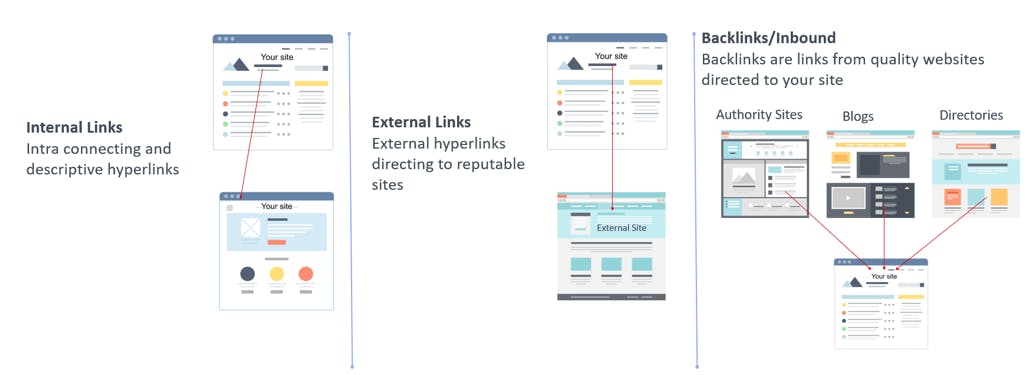
Website Authority & SEO
Inbound links, commonly referred to as backlinks, remain the single most important factor in improving your off-page SEO ranking. When sites outside of your own direct traffic to your website, it’s equivalent of nod or affirmation that your website has something they feel is valuable for their users to see. This assertion is equivalent to a positive review in the eyes of a search engine algorithm. It highlights that your website is something others believe has quality content and information for internet users.
Inbound links increase your domain authority and page rank. Domain authority is a score of 1 to 100 that predicts a website’s ability to rank on SERPs. When other sites recognize your page’s value, your domain authority goes up and your search engine page ranking will follow. When backlinks are attached to specific keywords or phrases, then they become associated with the whole notion of user engagement, an important ingredient in solidifying site authority.
There are numerous ways to earn backlinks, but not links are created equal. Manually earned backlinks are those which you ask another site owner to link back to you through link building techniques. Self-developed backlinks are those in which you place a link to your website in a forum or online listing that carries the least gravitas. Neither of these links is a great option for improving your domain authority.
Natural backlinks refer to organic or ‘earned’ links, for instance when a blog or website recognizes you without your intervention. Obtaining natural backlinks has become is vital to your SEO linking strategy. Unfortunately, these are also the hardest to come by. Natural backlinks are coveted and authentic, coming from editorial backlinks, guest blogging, and peer review sites. These links garner the highest ranking for site authority
While the number of backlinks used to be king, it’s clear that quality is now what matters most when it comes down to ranking. The quality of the link incorporates a number of different factors, including:
- How often are you acquiring backlinks
- How old is the link
- The text used to link back to you (e.g., does it incorporate a keyword or phrase?)
- The domain authority of the linking site
- Number of visitors the link garners
Brand Reputation: Social Media and Website Traffic

Brand Reputation
Social media is about more than sharing personal anecdotes and photos; it’s a powerful, motivating force for driving traffic toward companies that use it effectively and for nurturing brand advocates. On average, over 80 percent of people regularly use some form of social media. It’s imperative to tap into that.
Social media has become a major influence on off-page SEO. The more users who engage with your social media channels, the more search engines will take notice of your increasing brand popularity.
Social media is important for SEO because sharing of your content adds up to more visibility for your content. The more people share your content on social media, the more likely more people will link to it, and links are very important to SEO. Engage your audience and keep active by sharing the latest articles or blogs you published, or the latest products and services updates you posted. Encourage and appreciate feedback from visitors and use their feedback to make your site better.
In an era where social measurements such as likes are becoming irrelevant, the value of the share and comment will increase. Social interactions are shifting from one-click actions to a more mindful litmus test of credibility and relevance. This directly aligns with the added weight given to reviews and online referrals, both organically earned and seen as higher-ranking variables.

Social Media & SEO Factors
These external linking factors come together to help boost the popularity of your website as a whole through an increase in qualified traffic. At the end of the day, it is the amount of traffic that will not only help to drive up your SEO ranking, as well as conversion and success across key metrics. These results are achieved through building trust and rapport with users through multiple platforms and avenues.
Video and images are two other avenues that drive social interaction through your owned channels. These types of multimedia are more engaging, and also allow you to utilize social sites such as YouTube and Pinterest to their full potential. Users want to engage with your brand in multiple ways. Offering a number of social platform options can drive different types of users who are looking for similar content to your website.
The Direct Impact of Off-Page SEO
What can off-page SEO actually do for your ranking?
As we know, not all pages are equally ranked. Page ranking first came into practice when Google decided they would assign a ranking system to web pages based on the quality and quantity of its links. Over time, the quality of the link has taken precedence over the quantity, directly affecting the weight of the website overall. A clever off-site SEO strategy can help drive your page ranking which will increase your traffic and conversion rates.
Improving Your Site Authority
If you’re looking to drive up your SERP, off-site SEO is an integral method to help give you the boost you need. The more people are talking about you and engaging with you outside of your website, the higher domain and page authority you will earn. This, in turn, will show up on the search pages as you grow both organically and authentically.
Off-page SEO plays an immensely important role in the traffic, success, and positioning of your website. From quality natural links to meaningful social engagements, the continued focus on external factors affecting your brand reputation and positioning are not going away. Google is seeking to continually improve the ways they provide the best results for their users. By creating a 360-degree, multi-faceted web experience, you’re giving your website the best chance of being boosted and recognized where it counts most – on the SERP.
7 Steps to Great SEO
To be successful at SEO, there are seven key phases to get your site ready for technical adjustments and to build a great SEO strategy. Here are the seven steps to take to get ready for long-term SEO success:
Step 1: Do an audit
The first step is a technical and content audit to see how your existing assets are performing. The technical audit considers every element of your site that might have an effect on your SEO performance. This includes things like site speed, page structure, site security, and mobile optimization. The content audit – ideal for sites that have dozens of pages of content – examines what pages are useful for the user. The goal of the content audit is to make sure everything is up to date and still relevant to viewers.
Step 2: Improve technical SEO
After completing your audit, reach for the low-hanging fruit: the technical adjustments you can make to your site to improve SEO performance. This might include:
- Index Status – If your pages aren’t being indexed, then they are not being ranked. It could be a sign that the spiders may not be able to easily crawl your page or that your page is not relevant. You can view how many of your pages are indexed by checking the site: operator. If your pages are
not indexed, you should rectify the situation as soon as possible. - Crawl Budget – Crawlbudget is the frequency with which search engine’s crawlers go over the pages of your domain. The more often crawlers visit, the quicker your pages get into the index that is updated. You should make sure that
Improve Technical SEO
nothing on your website is actively hurting your crawl budget.
- 404 Errors – Any code within 400 to 499 indicates that the page didn’t load. The 404-response code is the only one that carries a specific meaning – that the page is gone and most likely isn’t coming back. If it is caused by a broken link, fix
the link. If the page was removed accidentally restore with an updated page or apply a 301 redirect to similar content. - Internal Links – Your internal link structure is crucial to your SEO success. Internal links are any links that connect your webpages to one another. Your link building strategy should align with your content and how it is structured, and where you ultimately want to send important link value.
- Sitemaps – Sitemaps provide search engines with a blueprint of how your website is laid out. You could manually create a sitemap by following XML sitemap code structure but it’s easier to generate a sitemap using the right tools, such as auditing software with a built-in XML sitemap generator or popular plugins like Google XML Sitemaps. Make sure you submit your sitemap to the search engines.
- Site/Page Speed– Site speed should be a top priority for your SEO efforts. If you don’t have a lot of technical ability in development, it might be a challenge to fix page speed issues so you should work with a developer to improve the overall performance of your site. Fast page speeds also result in a better mobile UX for people, who, in today’s world, expect fast websites.
- Redirects – Broken redirects are redirects that generate errors (such as
301 & Canonical URLs
404s) or are pointing to the wrong place. While the easiest way to prevent broken redirects is to not create redirects to begin with, you can’t always avoid that. Try not to change URL structures, create good URLs from the start and, don’t change your URLs if you don’t have to.
- Broken Links – When you remove a page from your website or change URLs during a website overhaul links can break. Before doing a 301 direct, try to replace the link first as a direct link always holds more value than a redirect. Link reclamation is a way to fix those broken links and gain lost link value. Link reclamation is the process of locating and fixing broken links on your website and contacting other websites that link to yours to replace their link to you.
- HTTPS – Because Google now flags unsecure websites it is important to install an SSL security certificate on your website.
All of these elements must be working properly for your SERP results to improve. Fixing one of these areas won’t make a significant difference; but, fixing them all can certainly impact your ranking.
Step 3: Keyword research
Keyword research is the process of coming up with words and phrases that users are searching for in relation to your company, competitors, and industry. Take time to learn about how people are searching and what they are typing into a search engine. You’ll need to incorporate some of those search terms into your website to help Google’s bot associate your site with the right moment in the customer journey. Make it easy for people to find you – and buy from you.
Step 4: Locate your business
Location is everything, even when you’re dealing with a virtual business. It’s imperative that you understand how your target consumer searches for local businesses and service providers. Include your contact information and some geographic data somewhere on your website, including your state and city. Google serves up sites that are geographically relevant. For example, if a customer in New York is searching for “book stores near me,” Google will crawl webpages looking for a business address or Google My Business listing. If you don’t have that information, you’re missing out on clicks.
If you don’t have a Google My Business page then it’s time to get one, especially if your business depends on local business. Make sure that you keep your Google My Business updated, and full of quality, online reviews from satisfied customers.
Step 5: Set a content strategy
There are three categories of content you must include on your website for SEO purposes. The first is foundational content. This is content that doesn’t change very often and includes your main keywords and topics. Keep foundational content focused on your products and services.
The second kind of content is FAQ content. This is informational content that answers common questions about your company, service or product, and industry. Make sure that this content is listed on an SEO-friendly URL that a bot can easily understand.
Finally, the last kind of content is authoritative content. This is content that demonstrates your expertise, knowledge, and what makes your business unique. Find ways to make this content particularly engaging by using video, images, infographics, and other multimedia. By setting a content strategy that covers these three types of material, you’ll satisfy both website visitors and Google’s SEO bots.
We talked about bounce rates earlier. Bounce rate is the percentage of visitors who visit a single page on a website and then don’t go further. Google doesn’t like high bounce rates but there is something that Google dislikes more. It’s called pogo-sticking. Pogo-sticking occurs when a user performs a search, clicks on a result, immediately clicks back to the search result page, and clicks on a different result. This occurs because of immediate dissatisfaction in the search result. Content plays a big role in pogo-sticking. If the content doesn’t match the title or meta description or looks spammy or is poorly written with misspellings and bad grammar, pogo-sticking will occur. Some other reasons for pogo-sticking include slow page speed and lots of popups.
Step 6: Write and edit content
Next, optimize your content by writing copy that speaks to specific audience personas. This might include blog articles, tutorials, e-books, or online articles that people will engage with and then convert to be customers. Remember, content is how you will build credibility and trust. It must be well written and edited for Google to even consider delivering it in a search query.
Step 7: Ranking your page
This is the step that you have the least control over. If you continually optimize the technical aspects of your page, and update your content with relevant and interesting information, over time your SERP will improve. The best way to improve your SEO is to know your audience, become a content master, and provide a great website experience.
Building an SEO Strategy
The saying “build it and they will come” is a nice sentiment. But when it comes to your website, hope does not spring eternal.
Luckily, there are strategies you can implement that will help get your site discovered. One of the most important elements of any website build is the incorporation of a seriously good SEO strategy. While links and content are hugely important, it is the backend part of SEO implementation that serves as the epicenter for all of your efforts.
Here is a comprehensive guide to the technical steps you should take to make your SEO efforts successful.
Localize your SEO efforts to get relevant customers
The importance of local search cannot be discounted. An overwhelming 4 out 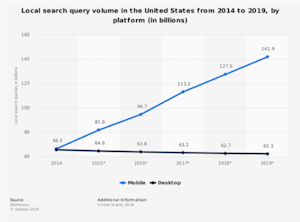
In order to optimize effectively, you need to ensure that Google can determine if your business is indeed local. Make sure your name, address, and telephone number appear consistently across all of your online postings and listings. As mentioned earlier, create a Google My Business account. Build quality off-page SEO links. Getting your business included in local directories is also a good strategy.
Build UI-Driven Site Architecture
Your site is only as good as a user’s ability to navigate it. If you’ve created a messy and difficult site experience, you’re going to have is a high bounce rate. You need to ensure that the site experience is stable and your navigation accurate. Make sure menu buttons and calls to action are clear and visible. The aim of your website is to keep users engaged with relevant content and keep them onsite for as long as possible to drive conversion. You want your website to foster the right type of user behavior; how it’s set up goes a long way to ensure that will happen.
Write Organized, Clean Code
When creating and maintaining your website, it’s essential to ensure that your code is clean and organized. You need to utilize best practices across your coding languages, as well as correct tagging and formatting. While every developer has their own style, following a set of principles will not only make it easier to make changes and updates in the future, but it will help your pages get indexed by Google. If Google can’t read your site, you’re missing out on easy wins from an indexing perspective. Set everything up in accordance with how Google operates to see infinitely better ranking results. Google needs to easily navigate and categorize the information it’s seeing. In the end, the more pages on your site Google is able to find and index, the higher your SERP and more likely your chances of discoverability.
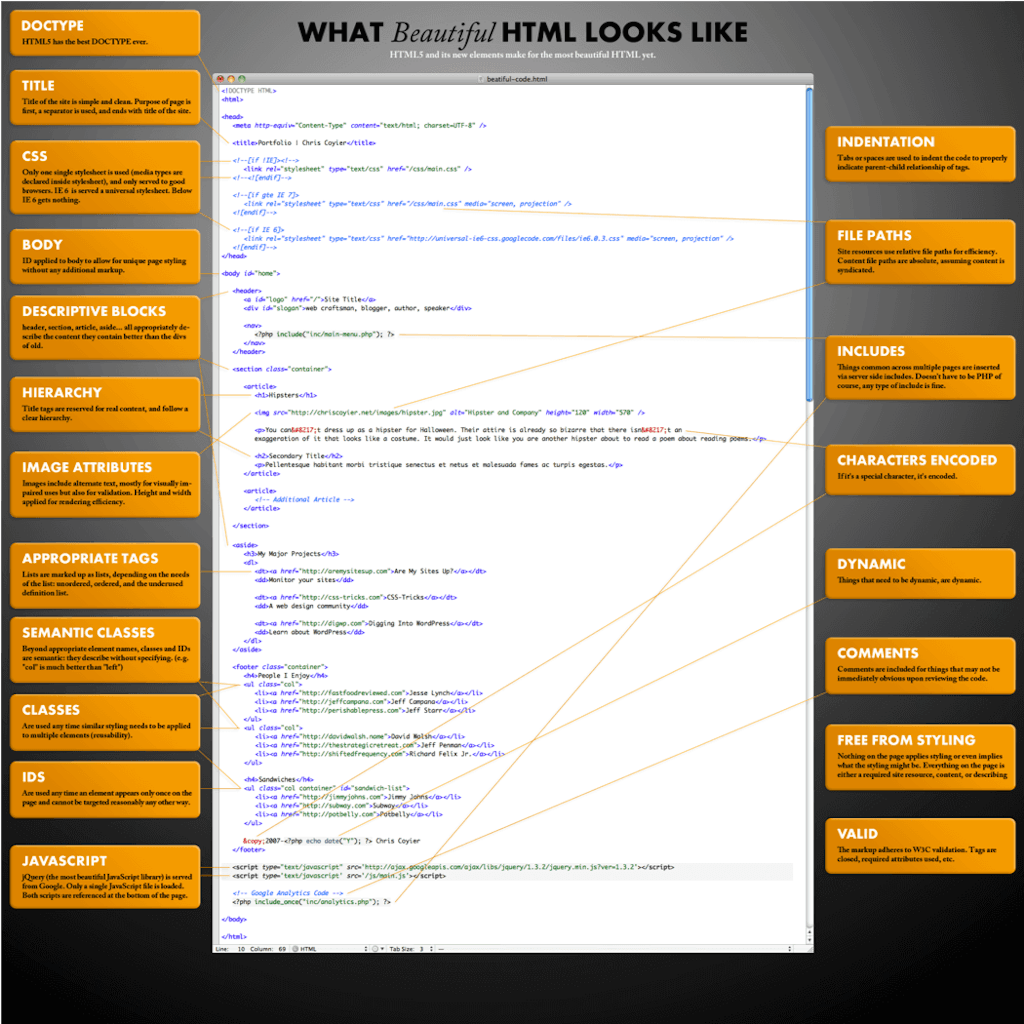
Clean HTML for better SEO
View full image here https://css-tricks.com/what-beautiful-html-code-looks-like/ from Chris Coyier
Make the Switch to HTTPS
Security is becoming more and more important for users when it comes to conducting certain actions on websites, such as transactions. Google has specified that increasing security measures, such as switching to HTTPS, will play a pivotal role in improving your page rank. The switch from HTTP to
HTTPS may cause some initial bumps in the road; however, it looks like it will be well worth it in the end. Standards continue to change, and more and more websites are making the transition. Plus, building a safe website experience for users will help build trust and credibility.
Create Relevant and Practical Navigation

SEO Friendly Navigation
As we’ve covered, your site architecture needs to support easy and effective navigation. Likewise, you need to make sure that your web pages are set up for successful conversions. Whether you’re selling a product, collecting customer information, or soliciting feedback for your business, users need to have a clear pathway to understand how to interact with your web pages. Make sure your site clearly delineates what actions need to happen where.
Start by understanding what actions you want users to take. If you’re looking for subscriptions, for example, make the “subscribe now” CTA prominent at the top of your page. Actions need to be clear and straightforward. Link your content to relevant actions across your site to help users find their way to what they need.
Improve Your Site Speed
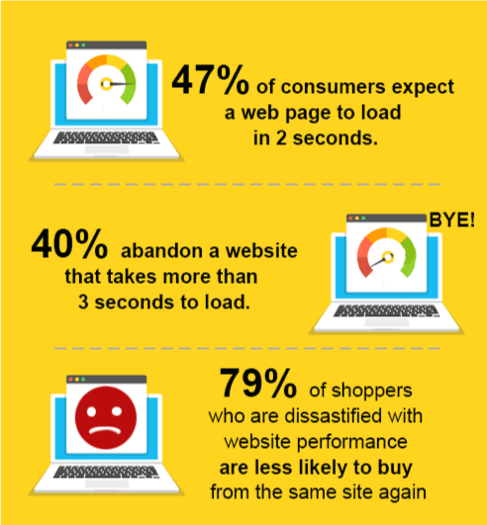
Improve Website Speed
As a user, site speed plays a major factor in how long you are willing to interact with a website. If a page is not loading fast enough, the bounce rate is certain to be high. Users want a site experience with a quick load time that supports the various actions they want to make, such as scroll or purchase. If you want to keep people engaged, make sure you’re allowing them to move through your site as quickly and seamlessly as possible.
Link to Quality Content
The relationship of link building to SEO has changed over the years: what was once a volume game has now been balanced out by a need for quality. Google has worked hard to eradicate the world of spam-filled web pages with terrible user experience. Google is forcing websites to put the user first in order to improve their SEO.
Building quality, relevant links is a key determining factor in your SERP. Internet users expect their searches to garner the most applicable results. They demand that Google send them to websites that are suitable and useful.
Optimize for Mobile Viewers
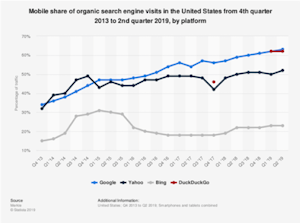
imperative from an SEO perspective: Google is now ranking mobile content above desktop when it comes to indexing.
It is staggering how many websites are still not mobile optimized. No matter how swanky your desktop experience is, if you don’t have a functional, optimized mobile option, you’re going to lose customers. It’s that simple. Embrace the change and give your website the chance to be a mobile hub for your users.
Leverage the Power of Social
The relationship between social media and SEO can feel quite abstract at times. As social channels look to change the way users interact with brands, the question remains how best to leverage social in order to drive improvements to your SEO.
Facebook, Twitter, and other social media channels are where customers are interacting with brands on a different level to the webpage. On Instagram and YouTube, viewers are on a mission to consume content that’s dramatically different from visiting a web page. It’s in the social sphere that the conversation is happening. Customers are looking for answers from brands outside of the traditional channels.
Google is monitoring what’s happening in that conversation. They use these comments to measure your brand reputation and relevance. Streamline your social media marketing efforts to focus customer feedback and get the best results out of your off-page activities.
Understanding how to improve your social media marketing overall is a great first step. It will help you take full advantage of how social can power SEO by engaging your audience and driving qualified traffic to your website.
Prioritize Content Marketing
Content is king when it comes to engaging with users across any digital platform. Developing a comprehensive and focused content marketing strategy is essential to building your SEO strategy. As your content plays such an integral role in on-site SEO practices, it makes sense that robust content marketing is a crucial tool to winning with SEO.
The role of a blog can feel truly redundant at times. It can be a time suck and there may appear to be little reward. However, analyze your organic traffic through the blog: the highest volume pages are often from blog posts from years before that have earned a high index over time. The trick is learning how to leverage older blog posts and make them relevant for users today.
Blogs and other forms of content marketing can keep users on your webpage and engaged. A solid content marketing strategy incorporates a 360-degree approach to the user journey and consumption behaviors.
Keyword Optimization
As you go through the SEO process, keyword optimization is one of the crucial building blocks to ensure your strategy and implementation are successful. Get your keywords wrong, and you’ll have a hard time seeing any change in your SEO ranking. Likewise, keyword optimization isn’t a “set it and forget it” one-time practice. You must continually update your keywords and make sure you’re expanding your reach.
Keyword Research Can help:
- Drive traffic to your page
- Help you assess the demand for your product or service
- Write great content
- Identify barriers to adoption for your key consumer groups
Keyword optimization touches nearly every part of your SEO strategy, from content to link building to site structure.
Where to Include keywords
The organic performance of your website depends largely on how well you integrate your keywords in every aspect of your website. Here are a few places where incorporating keywords is mission-critical:
- Title tags: target keywords must be included in the title, as this is the most important piece of content on your website
- Links: including internal links, navigational links, inbound links, and links within your content.
- Images: include keywords in your image alt attributes and file names
- Meta description: experts are conflicted as to whether to include target keywords in your text snippet, but make an effort to add optimized keywords to your meta tags
- URL: includes SEO keywords in the slugs (e.g., website.com/keyword-optimization).
- Site structure: group keywords in a hierarchy and as they correspond to subpages on your website
Some marketers also recommend adding keywords to your social media channels. This can improve your social media marketing efforts as well as drive engaged users to your landing page.
How to Evaluate Keywords
Which keywords and phrases are best for boosting your website? There’s both an art and a science to selecting the keywords you integrate across your site.
Popularity is the first quality you need to take into account when selecting keywords. The more popular a keyword is, the more people are searching for that word or phrase. That’s great because it will drive traffic to your website. However, the most popular search keywords also tend to be the most competitive. Popular keywords are harder to rank for because your competitors are likely targeting those keywords as well. Instead, try some of the closely related, but less popular variations on popular keywords. Use modifiers and synonyms to generate “long-tail keywords” that are easier to rank for overtime.
Keyword relevance is the next factor to consider when choosing your keywords and phrases. Relevance is an indication of how closely related a keyword is to what you’re offering on your website. For example, if you include keywords that are high value but have nothing to do with your product or service, your website ranking will dive. Are you delivering the information a user is searching for? Without relevance, it’s unlikely you will be able to make a conversion and your bounce rates will skyrocket.
Finally, keyword intent gets to the heart of what a searcher is really looking for. Where is a user in the customer journey when they search for your keyword? Are they browsing, ready to buy, or just looking
to gather information? For example, if you are offering lots of product information instead of making a hard sale, make sure your keywords aren’t all organized around the “buy now!” sentiment. Aim to use high intent keywords, those keywords that target users at the right stage of their customer journey. This will bring in qualified traffic and help raise your ranking.
Tools to Identify Keywords
There are a number of ways to find the best keywords for your landing page. Here are a few of the more popular options:
- The Free Keyword Tool
- Free Keyword Research Tools – the Ultimate Guide
- Keyword Research Master Class
- Keyword Research for Bloggers: 5 Part Guide
- Tools for Local Keyword Research
SEO is constantly evolving, and on-page and off-page SEO updates need to be performed to maintain and achieve organic rankings Not only will you need to update your content, but your strategy needs fine-tuning as Google makes changes to their algorithm. Google’s search engine bots get around 500-600 updates each year. Of course, some are minor, but others require significant adjustments to your strategy. The best way to mitigate the impact of Google’s updates is to work with an SEO agency that specializes in predicting and reacting to updates to the SEO algorithm. An SEO agency can keep you ahead of the game, as their sole mission is to understand and work with search engines. For more information and to start with your SEO audit, get in touch with the SEO marketing experts at Unreal.
ABOUT UNREAL WEB MARKETING
Our vast expertise has allowed us to create and optimize over one thousand full-featured websites for some of the country’s leading companies. Our web marketing initiatives have achieved top search engine rankings for these companies, allowing them to enjoy increased website traffic and accelerated business growth. UnReal Web Marketing has achieved over 40 Million top 10 positions for Fortune 500 companies since 1997. The diverse talent at UnReal Web Marketing has over 50 years of combined experience in Internet marketing and web design and has been instrumental in creating and optimizing more than 2,200 websites generating close to $150 million in sales for small to mid-sized companies throughout the United States.

David Montalvo is the Founder of UnReal Web Marketing with over 21 years of experience in SEO. He has worked with some of the largest companies in the U.S. such as jetBlue, Steinway Pianos, Mindray, Hestan, Yamaha, Daniel Gale, MLS, GoodYear, Grainger, U.S. General Services (GSA), and the State of Connecticut. David is a frequent keynote speaker on SEO, digital marketing, and entrepreneurship topics.
User Experience Is Still King: Core Web Vitals in 2025
In the ever-shifting world of SEO, few things stay the same. Algorithms evolve, user expectations rise, and yesterday’s best practices collect dust....
Inside Look: How Google, ChatGPT, and DeepSeek Manage YMYL Queries
YMYL—or “Your Money or Your Life”—refers to topics that can significantly impact a person’s health, finances, safety, or overall well-being. For...
What Modern Web Design Really Means in 2025
Why Looks Alone Aren’t Enough Anymore In the early days of the internet, web design was largely about appearances. If your site looked professional,...


